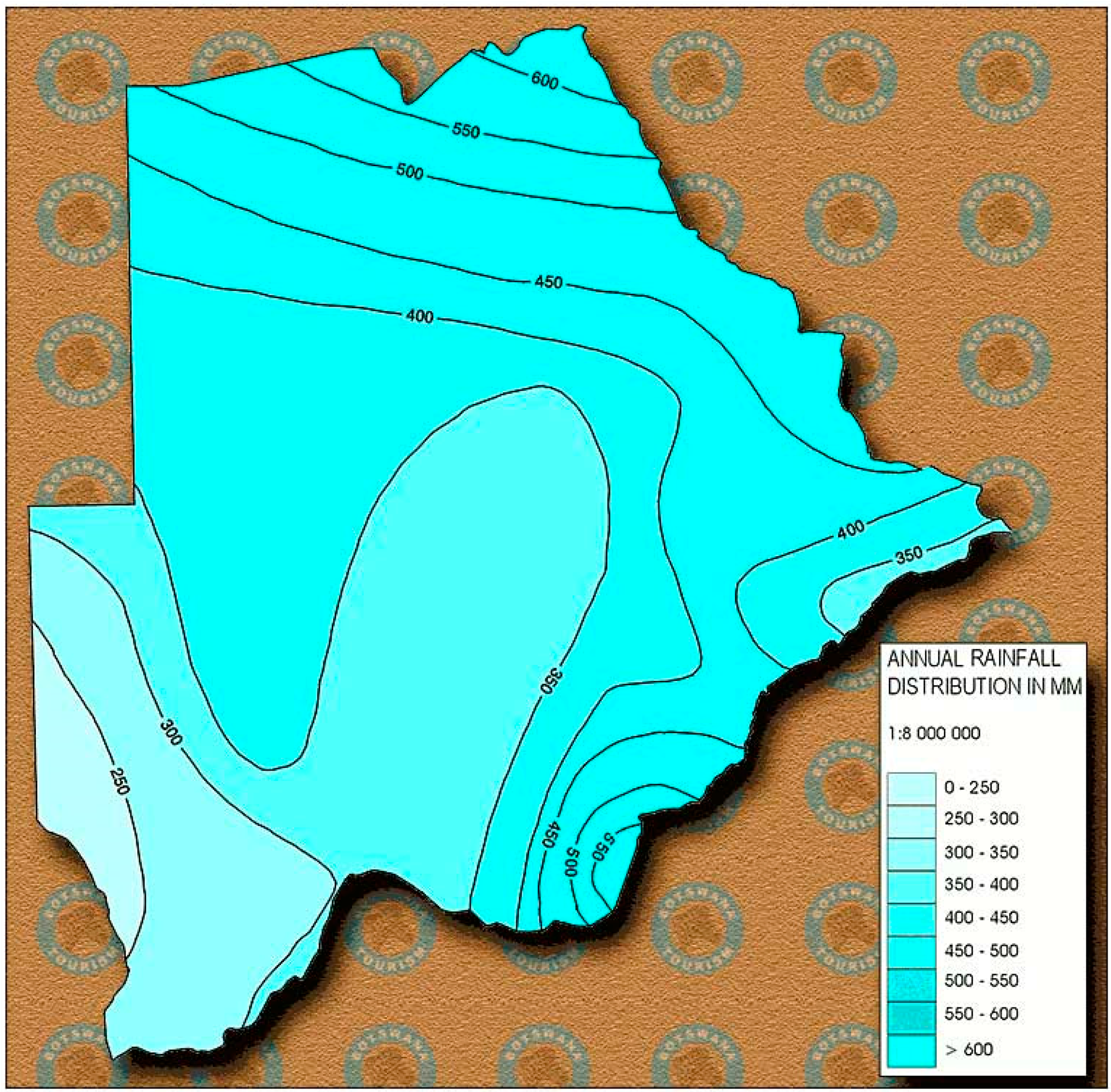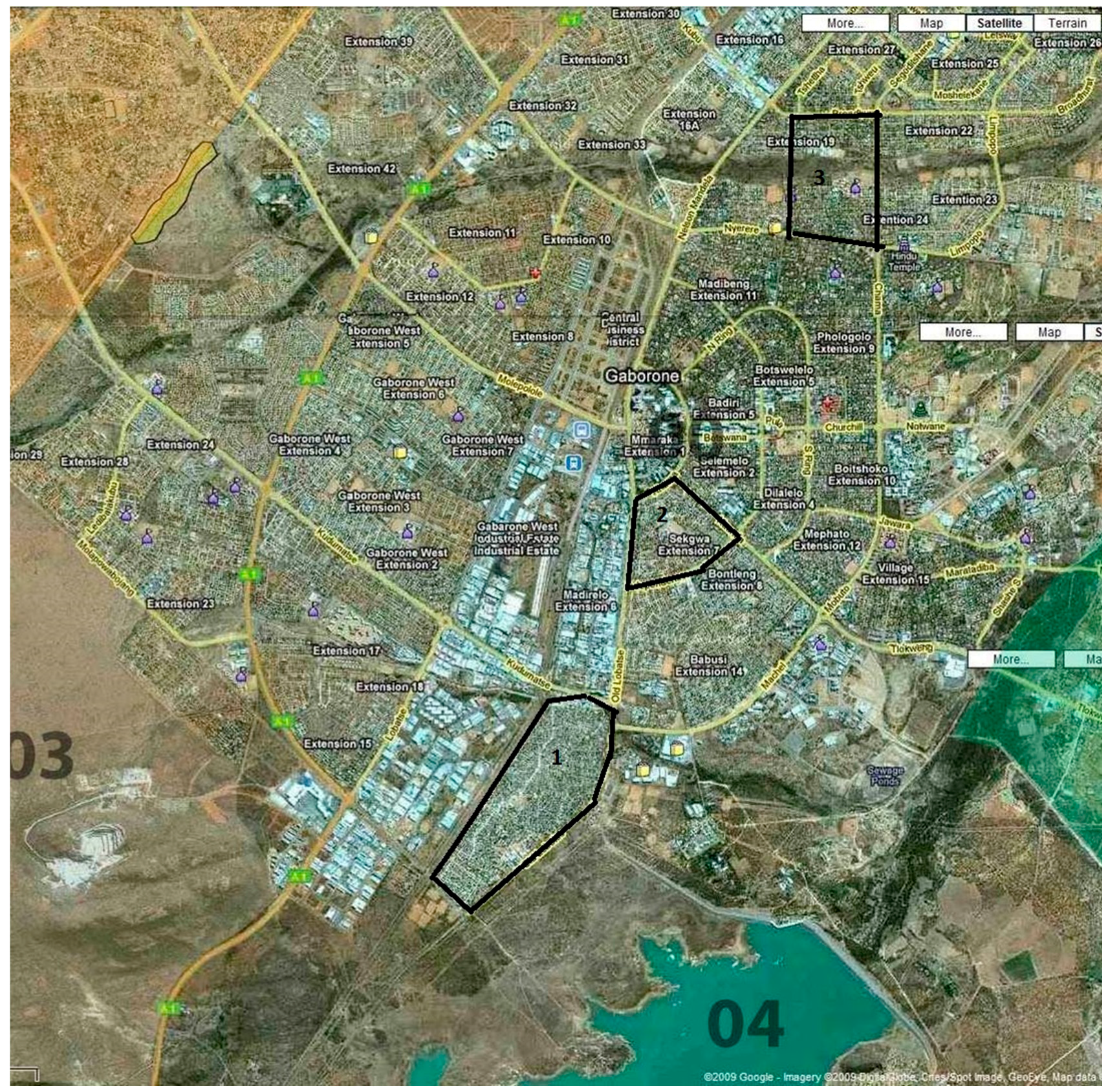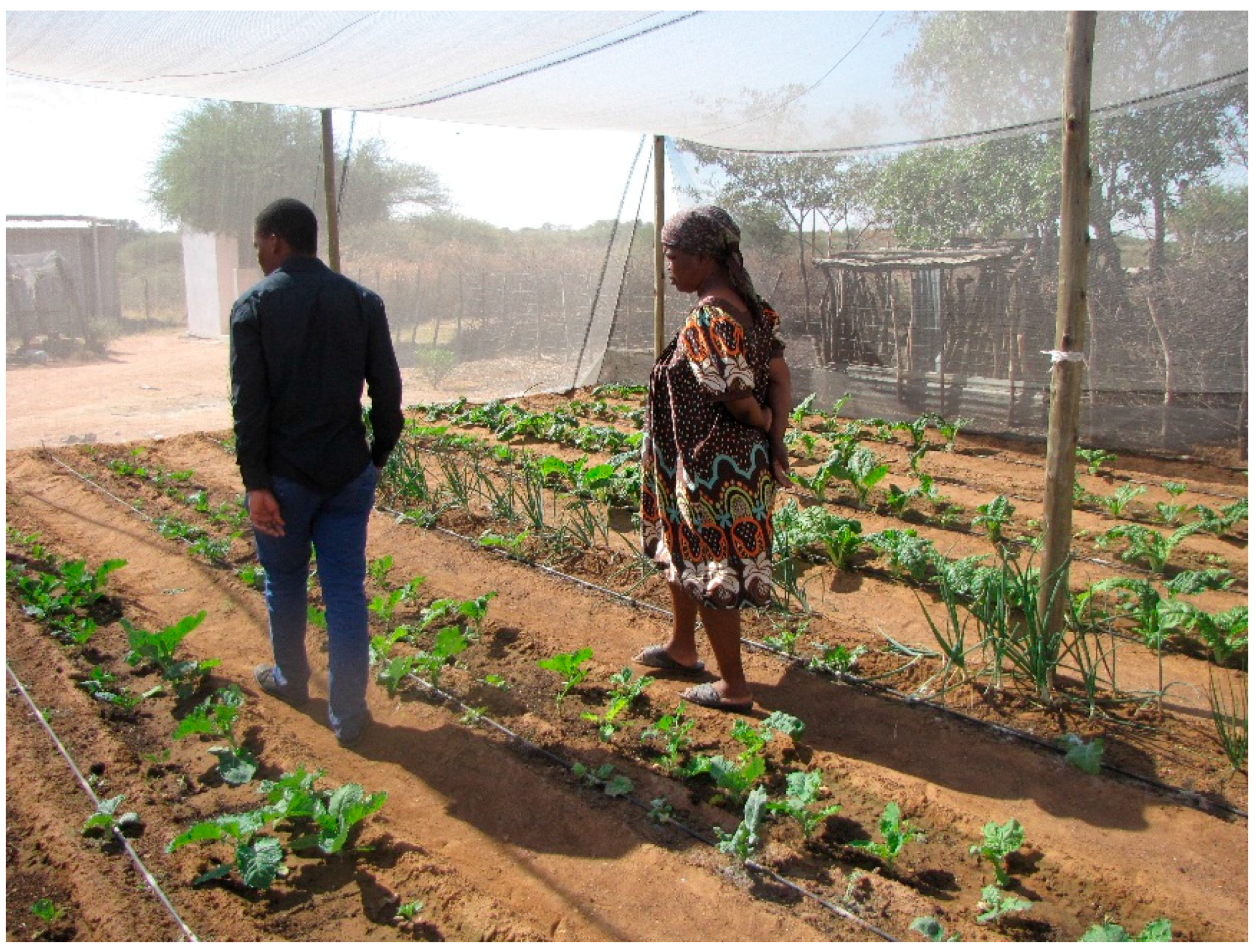Agriculture on the Brink: Climate Change, Labor and Smallholder Farming in Botswana
Abstract
:1. Introduction and Context in the Literature
2. Methods
3. Results
3.1. Food Insecurity
3.2. Agriculture, Poverty and Botswana’s Political Economy
3.2.1. Cattle
3.2.2. Diamonds
3.2.3. Eco-Tourism
4. Discussion
5. Conclusions
Acknowledgments
Conflicts of Interest
References
- Core Writing Team; Pachauri, R.K.; Meyer, L.A. Climate Change 2014: Synthesis Report. Contribution of Working Groups I, II and III to the Fifth Assessment Report of the Intergovernmental Panel on Climate Change; Intergovernmental Panel on Climate Change (IPCC): Geneva, Switzerland, 2014. [Google Scholar]
- De Sherbinin, A. Climate change hotspots mapping: What have we learned? Clim. Chang. 2014, 123, 23–37. [Google Scholar] [CrossRef]
- Batisani, N.; Yarnal, B. Rainfall variability and trends in semi-arid Botswana: Implications for climate change adaptation policy. Appl. Geogr. 2010, 30, 483–489. [Google Scholar] [CrossRef]
- Zhou, P.; Simbini, T.; Ramokgotlwane, G.; Hachigonta, S.; Sibanda, L.M.; Thomas, T.S. Botswana. In Southern African Agriculture and Climate Change: A Comprehensive Analysis; Hachigonta, S., Nelson, G.C., Thomas, T.S., Sibanda, L.M., Eds.; International Food Policy Research Institute: Washington, DC, USA, 2013; pp. 41–70. [Google Scholar]
- Temoso, O.; Villano, R.A.; Hadley, D. Agricultural productivity, efficiency and growth in a semi-arid country: A case study of Botswana. Afr. J. Agric. Resour. Econ. 2015, 10, 192–206. [Google Scholar]
- United Nationas Food and Agriculture Organization. Crop Water Information: Sorghum. Available online: http://www.fao.org/nr/water/cropinfo_sorghum.html (accessed on 8 February 2016).
- McCann, J. Maize and Grace: Africa’s Encounter with a New World Crop, 1500–2000; Harvard University Press: Cambridge, MA, USA, 2007. [Google Scholar]
- United Nations Food and Agriculture Organization. Crop Water Information: Maize. Available online: http://www.fao.org/nr/water/cropinfo_maize.html (accessed on 8 February 2016).
- Moalafhi, D.B.; Tsheko, R.; Atlhopheng, J.R.; Odirile, P.T.; Masike, S. Implications of climate change on water resources in Botswana. Adv. J. Phys. Sci. 2012, 1, 4–13. [Google Scholar]
- Botswana Tourism Organization. Annual Rainfall Map. Available online: http://www.botswanatourism.us/experience_botswana/annual_rainfall_map.html (accessed 21 June 2016).
- Government of Botswana. Botswana Committed to Tackling Climate Change. 2010. Available online: http://www.gov.bw/en/News/Botswana-committed-to-tackling-climate-change-/ (accessed on 8 February 2016). [Google Scholar]
- Kayawe, B. Hunger Heralds Climate Change’s Arrival in Botswana. 2015. Available online: http://www.ipsnews.net/2015/11/hunger-heralds-climate-changes-arrival-in-botswana/ (accessed on 6 February 2016).
- Government of Botswana. Botswana Climate-Smart Agriculture Program. 2015. Available online: http://canafrica.com/wp-content/uploads/2015/05/Botswana-CSA-Program.pdf (accessed on 8 February 2016).
- Southern African Development Community (SADC). News: Tripartite Climate Change 2014 Meeting. 2014. Available online: http://www.sadc.int/news-events/news/tripartite-climate-change-2014-meeting/ (accessed on 21 June 2016).
- Neufeldt, H.; Jahn, M.; Campbell, B.; Beddington, J.; DeClerck, F.; de Pinto, A.; Gulledge, J.; Hellin, J.; Herrero, M.; Jarvis, A.; et al. Beyond climate-smart agriculture: Toward safe operating spaces for global food systems. Agric. Food Secur. 2013, 2. [Google Scholar] [CrossRef]
- Sumberg, J.; Thompson, J. Contested Agronomy: Agricultural Research in a Changing World; Routledge: New York, NY, USA, 2012. [Google Scholar]
- Sen, A. Poverty and Famines; Clarendon: Oxford, UK, 1981. [Google Scholar]
- Kebakile, P. Rising Global Food Prices: Causes and Implications for Botswana. BiDPA Briefing. September 2008. Available online: http:/www.bidpa.bw (accessed on 21 June 2016).
- Moseley, W.G. Africa’s future? Botswana’s growth with hunger. Al Jazeera-English, 8 May 2012. [Google Scholar]
- Frayne, B.; Pendleton, W.; Crush, J.; Acquah, B.; Battersby-Lennard, J.; Bras, E.; Chiweza, A.; Dlamini, T.; Fincham, R.; Kroll, F. The State of Urban Food Insecurity in Southern Africa; Urban Food Security Series No. 2; Queen’s University: Kingston, ON, Canada; AFSUN: Cape Town, South Africa, 2010. [Google Scholar]
- Lado, C. Environmental and socio-economic factors behind food security policy strategies in Botswana. Dev. South. Afr. 2001, 18, 141–168. [Google Scholar] [CrossRef]
- Riley, L.; Legwegoh, A. Comparative urban food geographies in Blantyre and Gaborone. Afr. Geogr. Rev. 2014, 33, 52–66. [Google Scholar] [CrossRef]
- Watts, M. On the poverty of theory: Natural hazards research in context. In Interpretations of Calamity; Hewitt, K., Ed.; Allen and Unwin: Boston, MA, USA, 1983; pp. 231–262. [Google Scholar]
- Ribot, J. The causal structure of vulnerability: Its application to climate impact analysis. GeoJournal 1995, 35, 119–122. [Google Scholar] [CrossRef]
- Ribot, J. Vulnerability does not fall from the sky: Toward multiscale, pro-poor climate policy. In Social Dimensions of Climate Change; Mearns, R., Norton, A., Eds.; The World Bank: Washington, DC, USA, 2010; pp. 47–74. [Google Scholar]
- Bohle, H.G.; Downing, T.E.; Watts, M.J. Climate change and social vulnerability: Toward a sociology and geography of food insecurity. Glob. Environ. Chang. 1994, 4, 37–48. [Google Scholar] [CrossRef]
- Bryceson, D. The scramble in Africa: Reorienting rural livelihoods. World Dev. 2002, 30, 725–739. [Google Scholar] [CrossRef]
- Moseley, W.G. Paradoxical Constraints to Agricultural Intensification in Malawi: The Interplay between Labor, Land and Policy; Georgia Department of Geography Discussion Paper Series. No. 00-1; University of Georgia: Athens, GA, USA, 2000. [Google Scholar]
- O’Brien, K.L.; Leichenko, R. Double exposure: Assessing the impacts of climate change within the context of economic globalization. Glob. Environ. Chang. 2000, 10, 221–232. [Google Scholar] [CrossRef]
- O’Brien, K.L.; Leichenko, R. Winners and losers in the context of global change. Ann. Assoc. Am. Geogr. 2003, 93, 89–103. [Google Scholar] [CrossRef]
- Binns, T.; Nel, E. Beyond the development impasse: The role of local economic development and community self-reliance in rural South Africa. J. Mod. Afr. Stud. 1999, 37, 389–408. [Google Scholar] [CrossRef]
- Mkwambisi, D.D.; Frase, E.D.G.; Dougill, A.J. Urban agriculture and poverty reduction: Evaluating how food production in cities contributes to food security, employment and income in Malawi. J. Int. Dev. 2011, 23, 181–203. [Google Scholar] [CrossRef]
- Battersby, J. Beyond the food desert: Finding ways to speak about urban food security in South Africa. Geogr. Ann. Ser. B Hum. Geogr. 2012, 94, 141–159. [Google Scholar] [CrossRef]
- Battersby, J.; Marshak, M. Growing communities: Integrating the social and economic benefits of urban agriculture in Cape Town. Urban Forum 2013, 24, 447–461. [Google Scholar] [CrossRef]
- Kebadiretse, F. Batswana dismiss backyard gardening as “a big joke.”. Mmegi Online. 23 May 2011. Available online: http://www.mmegi.bw/index.php?sid=1&aid=1058&dir=2011/May/Monday23#comments (accessed on 6 February 2016).
- Rocheleau, D.E.; Thomas-Slayter, B.; Wangari, E. Feminist Political Ecology: Global Perspectives and Local Experience; Routledge: London, UK, 1997. [Google Scholar]
- Hovorka, A.J. Urban agriculture: Addressing practical and strategic gender needs. Dev. Pract. 2006, 6, 51–61. [Google Scholar] [CrossRef]
- Hovorka, A.J. The No. 1 Ladies’ Poultry Farm: A feminist political ecology of urban agriculture in Botswana. Gend. Place Cult. 2006, 13, 207–225. [Google Scholar] [CrossRef]
- Lesetedi, G.N. Urban-rural linkages as an urban survival strategy among urban dwellers in Botswana: The case of Broadhurst residents. J. Political Ecol. 2003, 10, 37–46. [Google Scholar]
- Coates, J.; Swindale, A.; Bilinsky, P. Household Food Insecurity Access Scale (HFIAS) for Measurement of Food Access: Indicator Guide; U.S. Agency for International Development: Washington, DC, USA, 2007.
- Rankokwane, B.; Gwebu, T. Characteristics, threats and opportunities of landfill scavenging: The case of Gaborone-Botswana. GeoJournal 2006, 65, 151–163. [Google Scholar] [CrossRef]
- Fehr, R. Exploring the Role of Horticulture in Alleviating Food Insecurity among Women in Botswana; Geography Honors Projects, Paper 48; Macalester College: St. Paul, MN, USA, 2016. [Google Scholar]
- Kajevu, Z. Poverty alleviation projects under scrutiny. Sunday Standard, 14 August 2013. [Google Scholar]
- Hillbom, E. Diamonds or development? A structural assessment of Botswana’s forty years of success. J. Mod. Afr. Stud. 2008, 46, 191–214. [Google Scholar] [CrossRef]
- Moseley, W.G.; Schnurr, M.; Bezner Kerr, R. Interrogating the technocratic (neoliberal) agenda for agricultural development and hunger alleviation in Africa. Afr. Geogr. Rev. 2015, 34, 1–7. [Google Scholar] [CrossRef]
- Moseley, W.G.; Carney, J.; Becker, L. Neoliberal policy, rural livelihoods and urban food security in west Africa: A comparative study of the Gambia, Côte d'Ivoire and Mali. Proc. Natl. Acad. Sci. USA 2010, 107, 5774–5779. [Google Scholar] [CrossRef] [PubMed]
- Food and Agricultural Organization of the United Nations (FAO). FAO Statistical Yearbook 2013; FAO: Rome, Italy, 2013. [Google Scholar]
- Twyman, C.; Sporton, D.; Thomas, D. ‘Where is the life in farming?’: The viability of smallholder farming on the margins of the Kalahari, Southern Africa. Geoforum 2004, 35, 69–85. [Google Scholar] [CrossRef]
- Cavrie, B.; Mosha, A.; Keiner, M. Chapter 3: Gaborone: An emerging urban oasis. In From Understanding to Action: Sustainable Urban Development in Medium Sized Cities in Africa and Latin America; Keiner, M., Zegras, C., Schmid, W., Salmeron, D., Eds.; Springer: New York, NY, USA, 2004; pp. 41–73. [Google Scholar]
- Peters, P. Embedded systems and rooted models: The grazing systems of Botswana and the commons debate. In The Question of the Commons; McCay, B., Acheson, J., Eds.; The University of Arizona Press: Tuscon, AZ, USA, 1987; pp. 171–194. [Google Scholar]
- Darkoh, M.B.K.; Mbaiwa, J.E. Globalisation and the livestock industry in Botswana. Singap. J. Trop. Geogr. 2002, 23, 149–166. [Google Scholar] [CrossRef]
- Samatar, A. An African Miracle: State and Class Leadership and Colonial Legacy in Botswana Development; Heinneman: Portsmouth, NH, USA, 1999. [Google Scholar]
- Swatuk, L.A. From “Project” to “Context”: Community based natural resource management in Botswana. Glob. Environ. Politics 2005, 5, 95–124. [Google Scholar] [CrossRef]
- Fragoso, A.D. Africa is Going through Serious Drought and El Niño is Making it Worse. Climate Progress, 21 January 2016. [Google Scholar]
- Turton, A.R. Precipitation, people, pipelines and power in southern Africa: Towards a ‘virtual water’-based political ecology discourse. In Political Ecology: Science, Myth and Power; Stott, P., Sullivan, S., Eds.; Arnold: London, UK, 2000; pp. 132–153. [Google Scholar]
- Kates, R. Cautionary tales: Adaptation and the global poor. Clim. Chang. 2000, 45, 5–17. [Google Scholar] [CrossRef]
- Kings, S. Subsistence farmers in a hot spot. Mail & Guardian, 29 May 2015. [Google Scholar]
- Sejabosigo, J. Botswana: Govt addresses water supply issues. AllAfrica.com, 5 March 2015. [Google Scholar]
- 1This index is based on three factors: exposure to extreme climate-related events; the sensitivity of populations, in terms of health, education, agricultural dependence and available infrastructure; and the adaptive capacity of countries to combat the impacts of climate change.
- 2COMESA-EAC-SADC stands for: Common Market for Eastern and Southern Africa—East African Community—Southern African Development Community.
- 3The term ‘political agronomy’ refers to the study of relationships and processes which link political, economic and social forces and factors to the creation and use of agronomic knowledge and technology [16].
- 4Feminist political ecology explores the role of gender in the political ecological landscape. These scholars see gender roles as socially constructed, yet important to consider when examining human-environment interactions. Such scholars have explored resource use, agrarian reconstruction and rural-urban transformation, among other topics [36].



| No. | Occurrence Questions |
|---|---|
| 1. | In the past four weeks, did you worry that your household would not have enough food? |
| 2. | In the past four weeks, were you or any household member not able to eat the kinds of foods you preferred because of a lack of resources? |
| 3. | In the past four weeks, did you or any household member have to eat a limited variety of foods due to lack of resources? |
| 4. | In the past four weeks, did you or any household member have to eat some foods that you really did not want to eat because of a lack of resources to obtain other types of food? |
| 5. | In the past four weeks, did you or any household member have to eat a smaller meal than you felt you needed because there was not enough food? |
| 6. | In the past four weeks, did you or any household member have to eat fewer meals in a day because there was not enough food? |
| 7. | In the past four weeks, was there ever no food to eat of any kind in your household because of a lack of resources to get food? |
| 8. | In the past four weeks, did you or any household member go to sleep at night hungry because there was not enough food? |
| 9. | In the past four weeks, did you or any household member go a whole day and night without eating anything because there was not enough food? |
| Sample Size | Demographic | Mean per Capita Income per Day | Percent Income Spent on Food | Food Security | ||
|---|---|---|---|---|---|---|
| Pula | USD | HFIA Score | Qualitative | |||
| 89 | All Urban | 25.5 | $3.55 | 35% | 2.8 | Moderate |
| 30 | Urban lower tercile | 1.71 | $.24 | 38% | 2.9 | Moderate |
| 30 | Urban middle tercile | 16.9 | $2.35 | 35% | 2.9 | Moderate |
| 29 | Urban upper tercile | 59.14 | $8.21 | 31% | 2.5 | Moderate |
| 30 | Peri-urban | 40.1 | $5.56 | 26% | 2.8 | Moderate |
| 39 | Rural | 12 | $1.67 | 61% | 3.2 | Moderate |
| Sample Size | Demographic | Food Secure | Mild Food Insecurity | Moderate Food Insecurity | Severe Food Insecurity |
|---|---|---|---|---|---|
| 89 | Urban | 24% | 20% | 12% | 44% |
| 30 | Peri-Urban | 27% | 7% | 23% | 43% |
| 39 | Rural | 18% | 6% | 19% | 57% |
© 2016 by the author; licensee MDPI, Basel, Switzerland. This article is an open access article distributed under the terms and conditions of the Creative Commons Attribution (CC-BY) license (http://creativecommons.org/licenses/by/4.0/).
Share and Cite
Moseley, W.G. Agriculture on the Brink: Climate Change, Labor and Smallholder Farming in Botswana. Land 2016, 5, 21. https://doi.org/10.3390/land5030021
Moseley WG. Agriculture on the Brink: Climate Change, Labor and Smallholder Farming in Botswana. Land. 2016; 5(3):21. https://doi.org/10.3390/land5030021
Chicago/Turabian StyleMoseley, William G. 2016. "Agriculture on the Brink: Climate Change, Labor and Smallholder Farming in Botswana" Land 5, no. 3: 21. https://doi.org/10.3390/land5030021
APA StyleMoseley, W. G. (2016). Agriculture on the Brink: Climate Change, Labor and Smallholder Farming in Botswana. Land, 5(3), 21. https://doi.org/10.3390/land5030021





